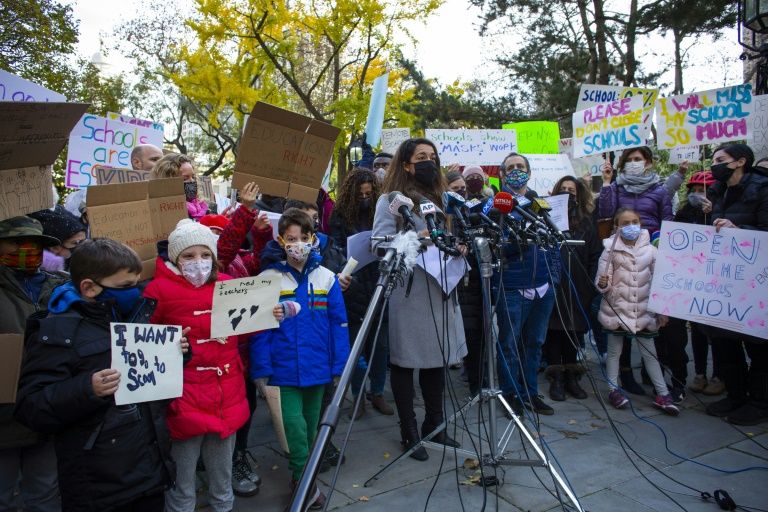New York school shutdown angers parents as gyms, bars stay open
New York (AFP) – New York’s public schools closed Thursday, sparking debate over whether the measure will help fend off a second coronavirus wave when classroom transmission is low and non-essential businesses remain open.
While European countries have so far kept schools open, focusing instead on shutting down indoor dining, bars and gyms, America’s most populous city has taken the opposite approach.
Mayor Bill de Blasio said Wednesday the United States’s biggest public school system, which teaches 1.1 million students, would revert to remote learning Thursday “out an abundance of caution.”
The announcement came after the city — where COVID-19 has killed more than 24,000 residents, most in the spring — recorded a seven-day average positivity rate of three percent.
“The data’s very clear that we have to keep our kids safe, our educators safe,” de Blasio told CBS Thursday.
The move is controversial though, with parents pointing out that recent testing has shown that schools are not the source of New York’s spike in infections.
Officials say the positivity rate in schools is just 0.23 percent.
Almost 13,000 New Yorkers have signed a petition entitled “Keep NYC Schools Open” that campaigners and kids delivered to city hall and state Governor Andrew Cuomo on Thursday.
In it, they argue that officials are sacrificing children’s futures to keep non-essential businesses open.
Cuomo has warned that New York City could soon be designated an “orange zone,” which would trigger the shutdown of non-essential activities including indoor dining and gyms, but for now they remain open.
“Exercising in a gym is not more important than educating the next generation of our city’s citizens. Eating indoors is not less dangerous than students sitting six feet apart with their masks on,” reads the petition.
The parents also say the school closures, which don’t force private schools to halt in-person learning, discriminates against poor families who struggle to afford childcare and depend on free school meals.
“The effect this is having on our kids is going to last a lifetime,” Megan Cossey, the mother of an 11-year-old, told AFP outside city hall.
– ‘More aggressive’ –
New York’s 1,800 public schools first closed on March 16 when the city became the early epicenter of America’s virus outbreak.
They were initially shuttered until April 20 before being shut until the end of the school year as the pandemic engulfed the Big Apple.
They began reopening in September when New York became America’s only major city to commit to offering in-person classes as part of a hybrid system that included online learning. About 300,000 children returned to classrooms.
Many cities, such as Chicago, Houston, Los Angeles, Philadelphia and Miami, opted solely for the virtual model.
As a condition for teachers returning to classrooms, de Blasio’s government agreed with powerful teaching unions that schools would close again if the three percent threshold was crossed.
Michael Mulgrew, president of the United Federation of Teachers, defended the shutdown, noting that health experts say it is right to be extra cautious going into next week’s Thanksgiving holiday.
“We have to get much more aggressive on areas where children are coming into buildings because we want them to be safe and their families to be safe,” he told News 12.
New York’s positivity rate is much lower than many areas of the US but it has crept up from the one percent it hovered around for much of summer and fall.
Jessica Justman, professor of epidemiology at Columbia School of Public Health, said it was right to close schools and that indoor dining and bars should follow.
“In order to stay ahead of the curve, to me it makes sense to put these restrictions in place,” she told AFP.
Disclaimer: Validity of the above story is for 7 Days from original date of publishing. Source: AFP.


